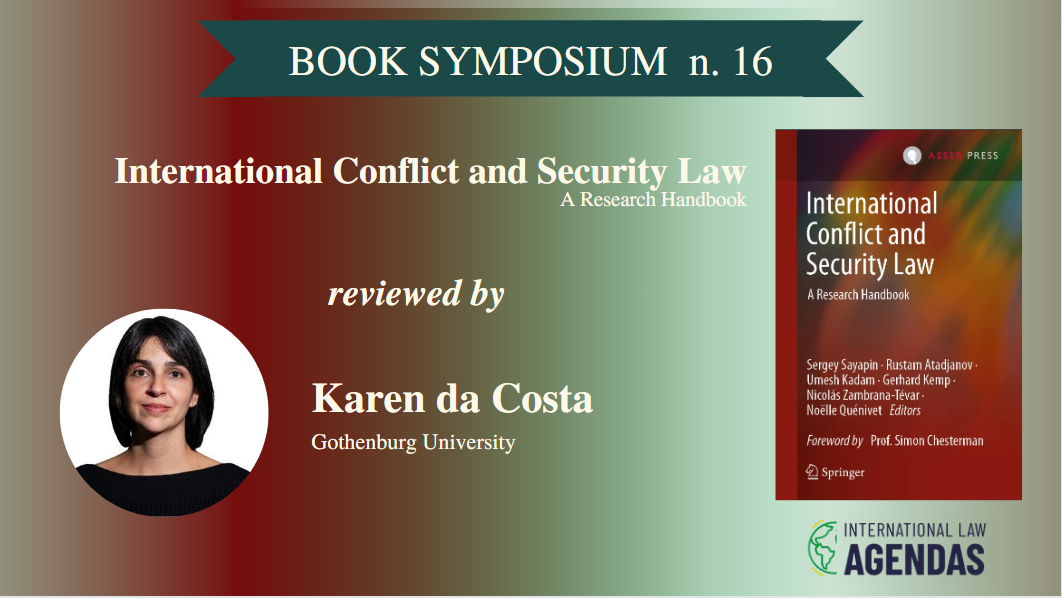At first sight, it may come across as a mega project, namely to collect so many chapters in two volumes. What is the added value of this initiative, one may ask. However, I am convinced that this ambitious enterprise really paid off, for the book provides a good overview of many relevant topics (from general to very specific topics), all of them speaking to the wide umbrella of conflict studies and the legal approach to them, namely, as the book name suggests, the volumes span over international conflict and security law (ICSL).
I highlight two positive aspects I particularly enjoyed in this book project. The first is that editors adopted a really good approach when assigning topics in each chapter and inviting authors to particularly engage on how do the selected topics speak to ICSL. I focus my attention here especially to part 1 of book 1 (Protected Values), where I noticed particularly in the chapter dedicated to the international rule of law (Chapter 3) that it competently demonstrates how a well-functioning international legal order affects the success of the whole system, including aspects of conflict and security. It illustrated in particular how the use of drones and the need for more transparency and accountability clearly demonstrates that we are still in need of working towards a better functioning international legal system. The same can be said in relation to the chapter on ‘Human Rights: Between Universalism and Relativism’ (Chapter 5). This contribution skilfully engages with the origins and the more traditional debate on the topic. However, it goes even further, looking on ways of resolving this debate, or, better saying, suggesting a reading of universalism taking into account postcolonial critiques. This may benefit the whole field of conflict and security studies and law more generally. It does not treat the conflict as either/or but in a more nuanced way, trying to accommodate differences while preserving core aspects of different cultures in a peaceful international order.
The second aspect I think is worth observing is the editors’ attempt to put together authors from very different backgrounds including geographic backgrounds, providing a truly diverse picture of the field. This is important and laudable, as it is not the common practice in legal books written in English, dedicated to an international audience. By combining multiple perspectives and experiences, the book offers a rich account of various topics, and provides truly thought-provoking material. For me who work with Global studies, the book provides good accounts for so many topics that can be explored further in class, or inform students’ masters dissertations, when engaging with theoretical frameworks of particular research ideas. In short, a good reference book to which to go back, when seeking inspiration and a good overview of the complexity of areas that speak to issues of conflict and security.
The remaining part of this review will highlight in more detail some aspects of the initial chapters of the book, that form Part 1 (Protected Values). Hence, the first five book chapters focus on international law related concepts: humanity, self-determination, international rule of law, Common Heritage of Mankind, and the tension between universal human rights and cultural relativism.
Chapter 1 focuses on the concept of “humanity” in international law. It highlights the importance of defining this concept, as it is a crucial component in different branches of international law such as international criminal law, international humanitarian law, and international human rights law. The article also notes that despite its incredible significance, the definition of humanity in international law is rather unclear and remains to be defined. Atadjanov therefore suggests in his chapter that a comprehensive definition of humanity at the international treaty level would be a welcome goal to be pursued, which should then be incorporated into relevant legal instruments. All in all, this contribution delineates the most topical issues pertaining to the value of ‘humanity’ and its role in international law in general and in ICSL in particular.
Chapter 2 covers the principle of self-determination, which gives people the right to self-rule. It is considered a fundamental principle in international law, but it is criticized for being full of gaps, inconsistencies, and contradictions. Kashnikov depicts self-determination here as an ineffective moral principle and more of a political tool. He further suggests that efforts to make self-determination a universal moral principle have failed. Therefore, the principle is rather portrayed as problematic due to misconceptions around it and is remains a rather outdated idea from the decolonization era. Overall, the piece is very critical of the principle of self-determination and adopts a more socialist orientation in its appraisal, reproaching mainstream Western/Northern accounts of the principle.
The third chapter focuses on the importance of the international rule of law for the international legal order and international conflict and security law. It defines the concept, which requires transparency, accountability, and compliance with international law, especially in the use of lethal force. The chapter explores both the formal and substantive elements of the international rule of law, including human rights protection and access to an effective remedy. Cullen and Gorobets highlight the challenges posed by the use of lethal force and the need to prioritize compliance with international law to ensure a strong foundation for the future development of international conflict and security law. I found this chapter particularly relevant, especially because it applies these concepts to the contemporary widespread use of drones in conflict, demonstrating the need for greater transparency and accountability in this regard.
The Common Heritage of Mankind (CHM) is the topic of chapter 4. The principle is a concept in international law that covers areas beyond national jurisdiction, such as the seabed and outer space. It was introduced in the 1960s and 70s and aims to prevent conflicts and promote a common interest for humanity. This is a quite technical piece covering a topic regulated especially in the law of the sea (e.g. UN Convention on the Law of the Sea). The principle consists of elements such as the prohibition of appropriation, reservation for peaceful purposes, equitable benefit sharing, and concerted management. Ventura and Mello Filho furthermore suggest that the CHM regime represent a shift from a state-oriented to a community-oriented paradigm in international law. I am not however sure I share the authors’ optimism regarding the current state of international law and its paradigms. Especially if one reflects upon the current conflict in Ukraine (that is, following Russia’s invasion of its territory in early 2022), it seems that unfortunately there is much room for improvement in relation to acceptance and observance of rules and principles that are relevant for humanity as a whole, and that neither merely serve states in isolation, nor just traditional elements of statehood. However, authors also suggest that the CHM principle should not be adopted without careful consideration and its normative nature should not be quickly assessed, so such parallel would deserve more thorough examination, which is beyond the scope of this review.
Chapter 5 examines the tension between universal human rights and cultural relativism in relation to peace and security. It builds on the work of post-colonial scholars and aims to address the conflicts between the two principles. Van Engeland focuses on the (still) very current debate and challenge of how to coexist with different cultures, religions, traditions, and customs while promoting both human rights and peace and security. She suggests that the relationship between universal human rights and peace and security needs to be re-evaluated, and the concept of liberal peace may need to be dismantled or re-imagined to fit within a new paradigm. The chapter provides a comprehensive analysis of the issues, sources of law, and possible ways to overcome the tension between universalists and relativists. The conclusion is however rather open, which is quite understandable, leaving room for further discussion, as these are not clear-cut issues that allow for easy disentanglement.
Further chapters that also caught my attention cover topical issues touching upon human rights and disaster situations, such as the one on due diligence obligations of international organisations engaged in disaster management (Chapter 24); and the one on the international humanitarian protection to disabled and elderly people in armed conflict zones (chapter 43). They demonstrate that the book truly covers a variety of topical, fascinating issues that deserve greater coverage by researchers and teachers alike.
All in all, this two-volume book amounts to a noteworthy achievement by providing an account of the field that can be used as starting point to any lecture, dissertation or academic discussion on the topics covered. I consider it a great contribution to those interested in the legal aspects of conflict and security. The book may even inform readers that do not work closely with ICSL, as the variety of topics it covers provide good entry points to topical issues, with loads of relevant references for future inquiry, that may inform the readers’ quest for more information also beyond the ICSL realm. A true achievement!
-

Karen da Costa is Senior Lecturer at the School of Global Studies, Gothenburg University, Sweden. Her research interests relate to the impact of disasters on human rights.





